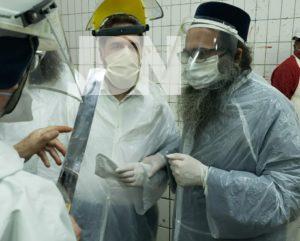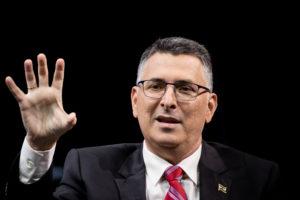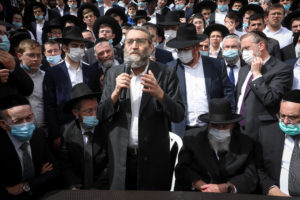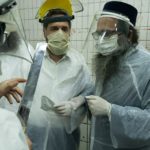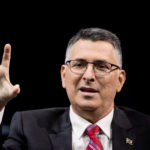“Just a month ago, our situation was far better than that of the Jewish community and the Haredim. But the situation for us today is now worse than both of them,” said Dr. Bishara Bisharat, who works in the Health Ministry’s coronavirus response unit.
According to Health Ministry figures Sunday, around 989,000 Israelis over the age of 16 have yet to receive a single dose of a coronavirus shot. Approximately 382,000 of them, or 39 percent, are Arab Israelis, although they constitute only 21% of the country’s population.
Factoring in those who have recovered from the coronavirus — who recently became eligible for a dose of the vaccine — does not significantly change the proportions. Around 68% of Arab Israelis aged 16 and up have either received at least one shot of a coronavirus vaccine or recovered from the virus, compared to 84% of the country as a whole.
For months, Israeli cities have been classified according to the so-called “traffic light” system, which scores cities based on infection stats and classifies them by color, with red indicating the highest infection rate. Of the 30 cities with the worst scores, 25 are Arab — including major population centers such as Umm al-Fahm, Nazareth, Kfar Qasim, and Majd al-Krum.
The Muslim holiday of Ramadan is set to begin in early April, meaning Arab Israelis had a critical window in which to get vaccinated, according to Dr. Zahi Saeed, who advises the Clalit health management organization on Arab health. The month-long festivities, in normal years, see large gatherings and family visits.
“Our expectation is that the numbers will continue to rise,” said Saeed. “I hope to God we’re wrong. Ramadan is on the way, and we don’t want to see a disaster.”
Health officials attribute the low vaccination turnout among Arab Israelis to the spread of rumors on social media.
“The vaccination rate is getting better, to be sure. But it remains low among Arab Israelis. This is because of fake news that spreads like wildfire on social media,” said Saeed.
The lag in vaccines appears to be playing a role in a surge in cases. About half of the over 700 patients hospitalized in serious condition are Arabs, mostly younger and unvaccinated, according to Channel 12 news.
The fast-spreading British variant of the novel coronavirus, Bisharat said, entered Arab society relatively late. But even so, Arab Israelis had not vaccinated enough to avoid its deadly effects.
“For the last two to three weeks, there’s been a fall in cases in Israel, including among the ultra-Orthodox. At the same time, we see a rise in Arab society — especially among younger people who aren’t getting vaccinated,” said Bisharat.
On a national level, around 13% to 14% of tests among Arab Israelis are coming back positive, Bisharat said, compared to a national figure of 4.3% across all communities. In some Arab cities, the positivity rate can rise to as high as 20 percent.
“On the one hand, this shows a drop in testing in our cities. But it’s also reflective of the fact that the infection is spreading widely in Arab communities,” Bisharat said.
Bisharat noted that Arab-Israel turnout rates appear to vary by region: relatively high rates in the Galilee, slightly lower in central Israel, with the southern Negev’s Bedouin population lagging far behind.
“In the beginning, there was enormous concern about the new vaccine. There wasn’t enough consciousness-raising being done to bring people to get vaccinated. We’re seeing a slight improvement, but the numbers are still low,” said Dr. Naim Abu Freiha, who directs a union of Bedouin doctors in the Negev.
The 10 Israeli towns with the lowest vaccination rates — together amounting to tens of thousands of residents — are all Bedouin towns in southern Israel, according to Health Ministry figures, most of them unrecognized.
“The unrecognized villages are a real problem. The vaccine has not yet been made available there in large part, and the response has accordingly been low,” said Abu Freiha, who directs a union of Bedouin doctors in southern Israel.
About 60% of Israel’s Bedouin population — some 175,000 people — live in unrecognized villages. Mostly cut off from running water and electricity, the controversial townships have long constituted a thorny policy dilemma.
“There’s enormous distrust between people and the state institutions,” said Salman ibn Hamid, a town official in Bir Hadaj, which was recently recognized by the government. “Remember, these are people who have seen home demolitions and mistreatment for decades. There are rumors running wild — that they want to sterilize us and get rid of us.”
Bir Hadaj has the dubious honor of having Israel’s lowest vaccination rate: only 1.35% of its around 5,800 residents receive at least one dose of a coronavirus vaccine.
Health officials say that they’re well aware of the problem. Temporary vaccination stations have been operated in Bedouin townships in the Negev in the hopes of increasing turnout.
“We’re trying to make solutions and bring the vaccine to them. We have regular operations with mobile vaccination stations to try and bring it into their communities. We’re trying to help — but not enough people are coming,” Saeed said.
Abu Freiha argued that Bedouins had been excluded from the beginning of Israel’s coronavirus rollout. But right now, he said, the lack of willingness to be vaccinated constituted the larger problem for Arab Israelis.
“Even if you live in an unrecognized village, you might have to drive twenty, thirty minutes to get a shot,” he said. “There’s clearly both a question of accessibility and a question of will — but at this point, I believe the latter is more important.”






